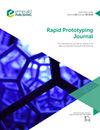Experimental characterization of the mechanical properties of 3D printed TPU auxetic cellular materials under cyclic compressive loadings
IF 3.6
4区 工程技术
Q1 ENGINEERING, MECHANICAL
引用次数: 1
Abstract
Purpose Fused filament fabrication (FFF) is a popular technique in rapid prototyping capable of building complex structures with high porosity such as cellular solids. The study of cellular solids is relevant by virtue of their enormous potential to exhibit non-traditional deformation mechanisms. The purpose of this study is to exploit the benefits of the FFF technology to fabricate re-entrant honeycomb structures using thermoplastic polyurethane (TPU) to characterize their mechanical response when subjected to cyclic compressive loadings. Design/methodology/approach Specimens with different volume fraction were designed, three-dimensionally printed and tested in uniaxial cyclic compressions up until densification strain. The deformation mechanism and apparent elastic moduli variation throughout five loading/unloading cycles in two different loading orientations were studied experimentally. Findings Experimental results demonstrated a nonlinear relationship between volume fraction and apparent elastic modulus. The amount of energy absorbed per loading cycle was computed, exhibiting reductions in energy absorbed of 12%–19% in original orientation and 15%–24% when the unit cells were rotated 90°. A softening phenomenon in the specimens was identified after the first compression when compared to second compression, with reduction in apparent elastic modulus of 23.87% and 28.70% for selected samples V3 and H3, respectively. Global buckling in half of the samples was observed, so further work must include redesign in the size of the samples. Originality The results of this study served to understand the mechanical response of TPU re-entrant honeycombs and their energy absorption ability when compressed in two orientations. This study helps to determine the feasibility of using FFF as manufacturing method and TPU to construct resilient structures that can be integrated into engineering applications as crash energy absorbers. Based on the results, authors suggest structure’s design optimization to reduce weight, higher number of loading cycles (n > 100) and crushing velocities (v > 1 m/s) in compression testing to study the dynamic mechanical response of the re-entrant honeycomb structures and their ability to withstand multiple compressions.循环压缩载荷下3D打印TPU膨胀多孔材料力学性能的实验表征
目的熔融丝制造(FFF)是一种流行的快速原型技术,能够构建具有高孔隙率的复杂结构,如蜂窝固体。细胞固体的研究具有重要意义,因为它们具有展示非传统变形机制的巨大潜力。本研究的目的是利用FFF技术的优势,使用热塑性聚氨酯(TPU)制造凹入式蜂窝结构,以表征其在循环压缩载荷下的机械响应。设计/方法/方法具有不同体积分数的样品被设计、三维打印并在单轴循环压缩中测试,直到致密化应变。实验研究了两种不同加载方向下五次加载/卸载循环的变形机理和表观弹性模量变化。实验结果表明体积分数和表观弹性模量之间存在非线性关系。计算了每个加载循环吸收的能量,显示出在原始方向上吸收的能量减少了12%-19%,在单元电池旋转90°时吸收的能量降低了15%-24%。与第二次压缩相比,在第一次压缩后发现了试样中的软化现象,所选试样V3和H3的表观弹性模量分别降低了23.87%和28.70%。观察到一半样品的整体屈曲,因此进一步的工作必须包括重新设计样品的尺寸。独创性本研究的结果有助于了解TPU凹入式蜂窝的机械响应及其在两个方向上压缩时的能量吸收能力。这项研究有助于确定使用FFF作为制造方法和TPU来构建弹性结构的可行性,这些结构可以作为碰撞能量吸收器集成到工程应用中。基于这些结果,作者建议对结构进行优化设计,以减少压缩试验中的重量、更高的加载循环次数(n>100)和破碎速度(v>1m/s),从而研究凹入式蜂窝结构的动态力学响应及其承受多次压缩的能力。
本文章由计算机程序翻译,如有差异,请以英文原文为准。
求助全文
约1分钟内获得全文
求助全文
来源期刊

Rapid Prototyping Journal
工程技术-材料科学:综合
CiteScore
8.30
自引率
10.30%
发文量
137
审稿时长
4.6 months
期刊介绍:
Rapid Prototyping Journal concentrates on development in a manufacturing environment but covers applications in other areas, such as medicine and construction. All papers published in this field are scattered over a wide range of international publications, none of which actually specializes in this particular discipline, this journal is a vital resource for anyone involved in additive manufacturing. It draws together important refereed papers on all aspects of AM from distinguished sources all over the world, to give a truly international perspective on this dynamic and exciting area.
-Benchmarking – certification and qualification in AM-
Mass customisation in AM-
Design for AM-
Materials aspects-
Reviews of processes/applications-
CAD and other software aspects-
Enhancement of existing processes-
Integration with design process-
Management implications-
New AM processes-
Novel applications of AM parts-
AM for tooling-
Medical applications-
Reverse engineering in relation to AM-
Additive & Subtractive hybrid manufacturing-
Industrialisation
 求助内容:
求助内容: 应助结果提醒方式:
应助结果提醒方式:


